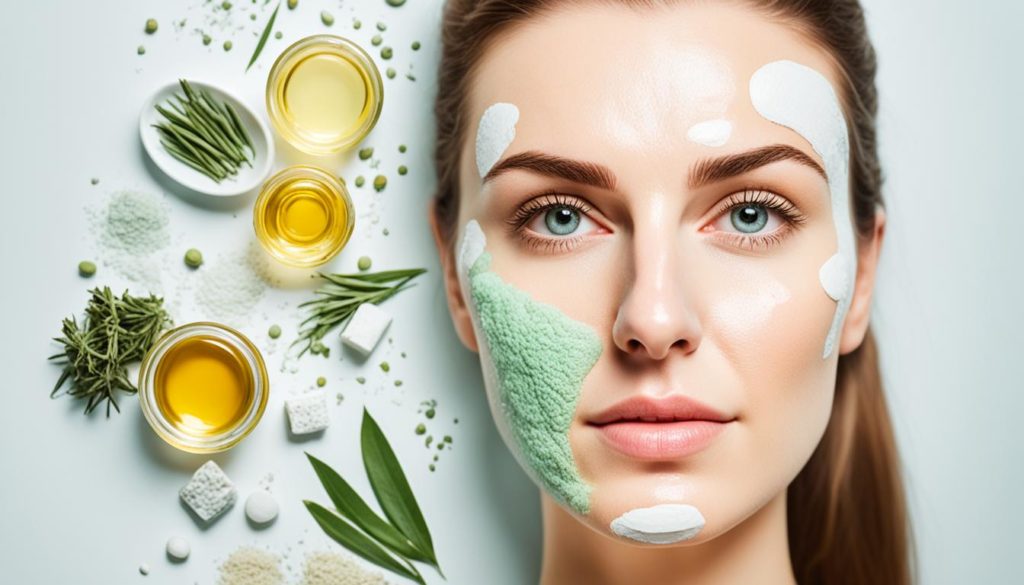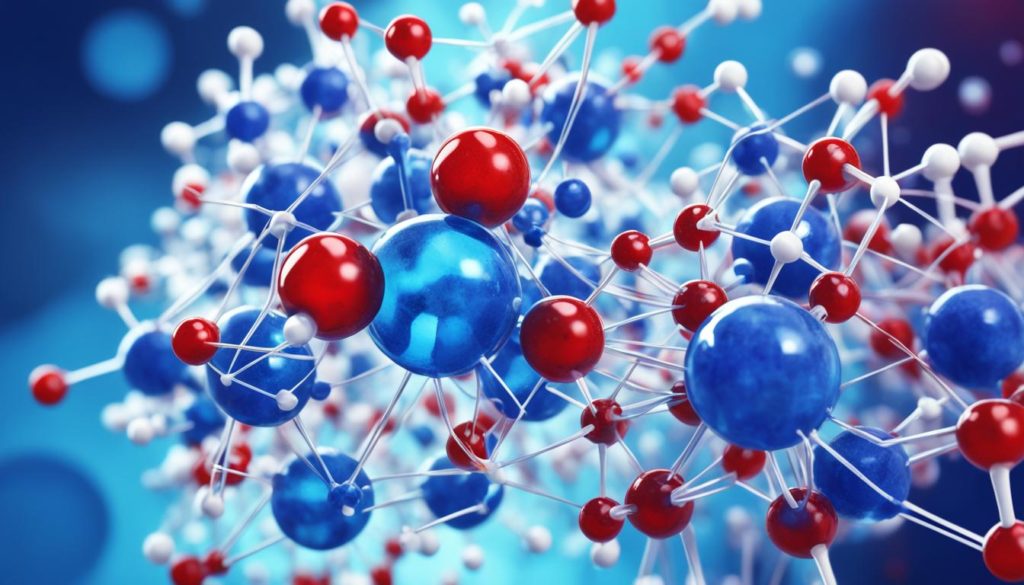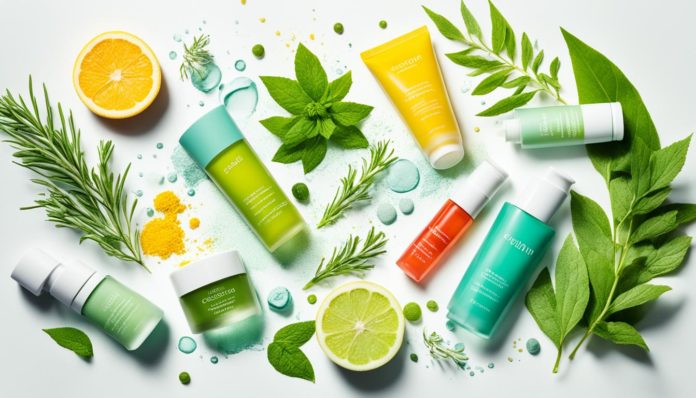Did you know that nearly 85% of Americans get acne at some point? Finding the right ingredients for acne-prone skin is essential. Knowing what works best can really help you get a clearer face.
We’ll look at the best stuff for acne-prone skin, based on science. We’re talking about salicylic acid, tea tree oil, and aloe vera. They’re famous for clearing acne well without irritating your skin.
Key Takeaways
- Acne affects nearly 85% of people in the United States.
- Salicylic acid is a powerful exfoliating ingredient for acne care.
- Benzoyl peroxide fights acne-causing bacteria.
- Natural remedies like tea tree oil and aloe vera are effective for gentle skincare for acne.
- Understanding the best ingredients for acne can help achieve a clearer complexion.
Understanding Acne-Prone Skin

Acne affects millions of people globally. To handle it well, learning about its causes and skin types is key. This knowledge helps in picking the right skincare items.
What Causes Acne?
Acne results from many factors. Hormonal changes during puberty or pregnancy boost sebum. Also, genetics, stress, diet, and pollution play roles. Using wrong skincare products can also make acne worse.
Types of Acne-Prone Skin
Oily skin produces too much sebum. Combination skin is part oily, part dry. Sensitive skin can breakout from harsh ingredients. Knowing your skin type aids in choosing correct products.
Why Skincare Ingredients Matter
The right skincare ingredients are crucial for acne care. Non-comedogenic products, salicylic acid, and benzoyl peroxide help. They prevent blocked pores and fight bacteria, improving skin health.
Salicylic Acid: The Exfoliating Powerhouse
Salicylic acid is a top choice for clearing skin, especially for those with acne. It’s a beta hydroxy acid (BHA), great for opening pores and helping skin renew itself.

Benefits of Salicylic Acid
It goes deep into pores, removing dead skin that cause breakouts. This makes salicylic acid very beneficial for acne-prone skin.
It also reduces redness and swelling, thanks to its anti-inflammatory effects. Using products with salicylic acid can make your skin look and feel better.
How to Use Salicylic Acid
To see benefits, it’s important to start slowly, using it 2 to 3 times a week. You can find it in cleaners, toners, and serums. Increase use as your skin gets used to it.
Remember to moisturize after to prevent dry skin. Pair it with niacinamide or hyaluronic acid for a balanced skincare routine. Here’s a guide to help you pick the best salicylic acid product:
| Product | Type | Key Benefits | Usage Frequency |
|---|---|---|---|
| Neutrogena Oil-Free Acne Wash | Cleanser | Deep cleanses, reduces oil | Daily |
| Paula’s Choice Skin Perfecting Liquid | Toner | Exfoliates, smooths texture | 1-2 times a week |
| The Ordinary Salicylic Acid 2% Solution | Serum | Targets acne, unclogs pores | 2-3 times a week |
Benzoyl Peroxide: The Bacteria Fighter
Benzoyl Peroxide is a standout choice among acne-fighting ingredients. It’s known for targeting acne-causing bacteria. This makes it a top pick in effective acne treatments.
Benefits of Benzoyl Peroxide
Benzoyl Peroxide works deep down to eliminate Propionibacterium acnes, the main acne culprit. It lowers the amount of bacteria on the skin. This helps lessen inflammation and clears blemishes.
It also prevents pores from clogging. This action reduces blackheads and whiteheads. With its antimicrobial power, Benzoyl Peroxide is key in many acne treatments. It fights existing breakouts and helps prevent new ones.
Application Tips for Benzoyl Peroxide
Adding Benzoyl Peroxide to your skincare routine requires some steps. These steps maximize its benefits and minimize irritation.
- Start Slow: Begin with a low concentration, like 2.5%, and increase it gradually.
- Spot Treatment: At first, use it only on blemishes instead of applying it all over.
- Moisturize: Use a non-comedogenic moisturizer to avoid dryness and keep the skin hydrated.
- Sun Protection: Sunscreen is a must daily because Benzoyl Peroxide increases sun sensitivity.
Including Benzoyl Peroxide in your skincare can be a big move against acne. Proper use will help make clearer skin a reality.
Natural Remedies: Tea Tree Oil and Aloe Vera
Tea Tree Oil and Aloe Vera are top natural remedies for acne. They have proven their worth in skincare for acne-prone skin. Both offer properties that reduce breakouts and make skin healthier.
Tea Tree Oil is known for its antibacterial and anti-inflammatory qualities. It comes from the Melaleuca alternifolia plant. This essential oil cleans deep into the skin, targeting pores. It removes blackheads, whiteheads, and pimples. Botanical studies show Tea Tree Oil is a strong natural acne fighter. It treats existing acne and stops new ones by managing oil production.
Aloe Vera stands out for its calming and anti-inflammatory effects. It’s especially good for irritated and inflamed acne-prone skin. Aloe Vera moisturizes the skin without making it oily. This makes it ideal for those with acne.
- Antibacterial Effects: Both Tea Tree Oil and Aloe Vera fight acne-causing bacteria with their antibacterial power.
- Anti-inflammatory Properties: They lessen inflammation, making the skin less red and sore.
- Hydration Without Oil: Aloe Vera hydrates without leaving your skin greasy, perfect for acne-prone skincare.
- Preventative Care: Tea Tree Oil keeps acne away by balancing skin oil levels.
Here’s a table that shows how well they work together:
| Property | Tea Tree Oil | Aloe Vera |
|---|---|---|
| Antibacterial | ✔️ | ✔️ |
| Anti-inflammatory | ✔️ | ✔️ |
| Hydration | ❌ | ✔️ |
| Oil Control | ✔️ | ❌ |
The Role of Retinoids in Acne Treatment
Retinoids are key in skincare for making skin look young and treating acne. They come from vitamin A and are great for fighting acne. They speed up cell growth and stop pores from getting clogged.
Benefits of Retinoids
Retinoids offer many benefits for those with acne. They help by:
- Promote cell turnover: They speed up the removal of dead skin to keep pores clear.
- Reduce inflammation: They lower redness and swelling, common in acne-prone skin.
- Stimulate collagen production: They help reduce acne scars over time and improve skin texture.
- Prevent future breakouts: Retinoids help keep skin cells shedding properly, so pores stay clear.
How to Integrate Retinoids into Your Routine
Adding retinoids to your skincare can change your skin. But, you need to be careful to avoid irritation. Here’s the right way:
- Start Slowly: Use retinoids once or twice a week at first. This lets your skin get used to them.
- Use a Pea-Sized Amount: A little goes a long way. Using too much can irritate your skin.
- Apply at Night: Sunlight can make your skin sensitive with retinoids. It’s best to apply them in your night routine.
- Hydrate and Moisturize: Always moisturize afterward. It keeps your skin from getting dry.
- Avoid Combining with Other Strong Actives: Some ingredients, like benzoyl peroxide, can make retinoids less effective. Use them at different times.
Following these steps will let you add retinoids into your routine. This will allow you to enjoy their big benefits for your skin.
Ingredients for Acne Prone
Finding the right ingredients is key to manage acne-prone skin. Using gentle skincare products can help reduce breakouts. We’ll show you top ingredients and how to create a good skincare routine.
| Ingredient | Benefits | How to Use |
|---|---|---|
| Salicylic Acid | Exfoliates and unclogs pores | Incorporate into cleanser or spot treatment |
| Benzoyl Peroxide | Kills acne-causing bacteria | Use in a cream or gel form |
| Niacinamide | Reduces inflammation and redness | Apply as a serum or moisturizer |
| Aloe Vera | Soothes and hydrates the skin | Use in gel form, preferably pure aloe |
| Tea Tree Oil | Antimicrobial properties | Apply as a diluted spot treatment |
To integrate these ingredients, start with a non-comedogenic cleanser. It ensures your pores stay clear. If needed, add a toner. Afterwards, use a serum like niacinamide for redness. To finish, moisturize with a light, non-comedogenic product.
Dermatological research shows these ingredients work. Many user reviews confirm this. Make sure products are non-comedogenic. This ties in with gentle acne skincare, promoting a balanced treatment route.
Niacinamide: Reducing Inflammation and Redness
Niacinamide, also known as vitamin B3, is a key player for those with acne issues. It’s great at easing inflammation and cutting down redness. Using it could make a big difference in tackling acne and boosting skin health.
Niacinamide Benefits
Niacinamide offers a lot, especially in fighting acne effectively. It does more than soothe inflammation. It also makes pores appear smaller, softens fine lines, and guards the skin from pollutants.
- Reduces Inflammation: Niacinamide’s anti-inflammatory properties are key for calming irritated skin.
- Minimizes Pores: With regular use, it can make large pores look smaller for a smoother feel.
- Hydrates and Protects: It helps keep moisture in and protects skin from outside harm.
How to Use Niacinamide
Adding niacinamide to your skin care is easy. Experts suggest beginning with a small amount to avoid irritation.
- Cleansing: Start with a gentle cleanser to get rid of dirt.
- Application: Put on niacinamide serums or creams right after washing and before moisturizing.
- Frequency: For the best effect, use it both morning and night every day.
| Benefit | Action |
|---|---|
| Reduces Inflammation | Calms red and irritated areas |
| Minimizes Pores | Visibly reduces pore size |
| Hydrates and Protects | Enhances skin barrier function |
Hyaluronic Acid for Hydration
Hyaluronic acid is key for acne-prone skin care, as hydration is very important. This molecule is found naturally in the skin and helps maintain moisture. It does this without making the skin oily.
Adding hyaluronic acid to your skincare helps keep your skin hydrated. It also avoids clogging pores. This is great for those who need non-comedogenic products, which don’t worsen acne.
“Hyaluronic acid is a key component in skincare for acne-prone skin due to its ability to retain over 1,000 times its weight in water, ensuring skin stays plump and hydrated without adding extra oil,” says Dr. Joshua Zeichner, a renowned dermatologist.
Studies show hyaluronic acid doesn’t clog pores. It’s ideal for sensitive and acne-prone skin types. Below is a comparison that shows its benefits:
| Benefits | Hydration Impact | Pore-Clogging Potential |
|---|---|---|
| Hyaluronic Acid | High | None |
| Squalane | Moderate | Low to None |
| Glycerin | High | Low |
This comparison highlights how well hyaluronic acid hydrates without clogging pores. It is very effective for acne-prone skin skincare.
Non-Comedogenic Moisturizers
Finding the right moisturizer for skin that’s prone to acne is very important. Hydration plays a big part in taking care of your skin. But it’s essential to choose a moisturizer that won’t block your pores. This helps to avoid new breakouts. Let’s dive into some advice from experts to make choices that favor mild skincare for acne.
Choosing the Right Moisturizer
Look for moisturizers marked “non-comedogenic.” This means they won’t clog your pores. Try to stay away from products that contain heavy oils. These can make skin issues worse.
Doctors often suggest using moisturizers with special ingredients like hyaluronic acid and niacinamide. These help keep your skin hydrated. They do this without irritating your skin or blocking your pores. This makes them a good choice for gentle skincare aimed at fighting acne.
Top Non-Comedogenic Ingredients
Some ingredients are known for not clogging pores and are good for skin prone to acne.
- Hyaluronic Acid: A strong moisturizer that pulls in moisture without making skin oily.
- Glycerin: Helps pull moisture to the skin, keeping it hydrated and soft.
- Ceramides: Vital lipids that fix the skin’s barrier and hold in moisture.
- Niacinamide: Reduces swelling and calms irritation with its anti-inflammatory properties.
For a detailed look at non-comedogenic moisturizers, check out this comprehensive guide.
It’s important to avoid certain ingredients too. Coconut oil and petrolatum can lead to clogged pores. Pick products that focus on gentle care for acne-prone skin. They should include the non-comedogenic ingredients we recommend.
| Ingredient | Benefits | Drawbacks |
|---|---|---|
| Hyaluronic Acid | Hydrates without oil | None noted |
| Glycerin | Maintains moisture | None noted |
| Ceramides | Restores skin barrier | None noted |
| Niacinamide | Reduces inflammation | None noted |
Always think about what your skin needs. Talk to a dermatologist if you’re not sure. Choosing the right non-comedogenic ingredients can really change your skincare routine. It promotes a clearer, healthier skin without the stress of acne coming back.
Ingredients to Avoid for Acne-Prone Skin
For those with acne-prone skin, choosing the right skincare products is key. Certain ingredients can block pores and make acne worse. This can throw you off your path to clear skin.
Common Pore-Clogging Ingredients
Some ingredients are well-known for causing pore blockages, leading to more acne:
- Sulfates – These are in many cleansers and can strip away natural oils. This can cause the skin to produce too much oil.
- Mineral Oil – Although it’s moisturizing, it’s too thick for acne-prone skin and can block pores.
- Lanolin – Coming from sheep’s wool, this ingredient is too heavy and can cause breakouts.
- Isopropyl Myristate – It gives products a smoother feel but can clog your pores easily.
- Silicones – Used in makeup and primers, they create a film on the skin that traps dirt and oil.
How to Read Ingredient Labels
Knowing how to read labels is important for managing acne-prone skin. Here are some tips to make it easier:
- Check Comedogenic Ratings – Ingredients have ratings from 0-5 for pore-clogging risk. Choose products with ratings of 0-2.
- Avoid Fragrances – Artificial scents can irritate your skin and lead to pimples.
- Less is More – Shorter ingredient lists are usually better for sensitive skin types.
- Look for Non-Comedogenic Labels – Products should say they won’t clog pores.
- Patch Test New Products – Always try a bit on your wrist or behind your ear before using it on your face.
By staying away from certain ingredients and learning how to read labels, you can find the best products for your skin. This will help you on your journey to clearer skin.
Conclusion
Wrapping up, knowing the best acne fighters can really boost your skincare game. Ingredients like salicylic acid and benzoyl peroxide work wonders. Natural options such as tea tree oil and aloe vera are awesome too. They help fight inflammation, bacteria, and oily skin.
When dealing with acne, it’s crucial to use gentle skincare. Niacinamide can calm redness and swelling. Hyaluronic acid keeps the skin hydrated without clogging pores. Also, look for non-comedogenic moisturizers. They keep your skin soft without making acne worse. Always check product labels to avoid pore-clogging ingredients.
With this info, you can choose skincare products wisely. Focus on the best ingredients for acne and gentle care. Clear, healthy skin can be yours with the right approach. Aim for effective treatments and you’ll meet your skincare goals.
FAQ
What are the best ingredients for acne-prone skin?
Great ingredients for acne-prone skin include Salicylic Acid and Benzoyl Peroxide. Tea Tree Oil, Retinoids, Niacinamide, and Hyaluronic Acid are also effective. They provide gentle care and long-term results.
What causes acne?
Acne results from excess oil, clogged follicles, bacteria, hormonal imbalances, and inflammation. Effective acne skincare targets these issues.
What are the types of acne-prone skin?
Acne-prone skins are oily, combination, or sensitive. Each needs specific routines and products to manage breakouts.
Why do skincare ingredients matter for acne-prone skin?
The right skincare ingredients for acne-prone skin reduce inflammation and clean pores. They actively fight acne-causing bacteria, leading to clearer skin.
What are the benefits of Salicylic Acid?
Salicylic Acid is a BHA that exfoliates, unclogs pores, and lowers inflammation. It’s highly effective against acne.
How should Salicylic Acid be used?
Use Salicylic Acid as instructed, in cleansers or toners. Start with a low dose. Increase slowly to prevent irritation.
What are the benefits of Benzoyl Peroxide?
Benzoyl Peroxide kills acne’s bacteria. It reduces acne’s severity and frequency effectively.
How should Benzoyl Peroxide be applied?
Apply Benzoyl Peroxide in small doses to acne-prone spots on clean skin. Start with a low dose and moisturize to avoid irritation.
Are there natural remedies for acne?
Yes. Tea Tree Oil, with antibacterial properties, and Aloe Vera, reducing inflammation, are good natural remedies for acne.
What are the benefits of Retinoids in acne treatment?
Retinoids, Vitamin A derivatives, speed up cell turnover, reduce pore clogging, and prevent new acne. They’re great for acne and scars.
How can Retinoids be integrated into a skincare routine?
Start with a pea-sized retinoid at night on clean skin. Ramp up slowly to avoid irritation. Use sunscreen in the day as skin gets sensitive.
What should be considered in choosing non-comedogenic moisturizers?
Choose non-comedogenic moisturizers. Look for Hyaluronic Acid, Glycerin, and Niacinamide for hydration without breakouts.
What ingredients should be avoided for acne-prone skin?
Avoid alcohol, essential oils, coconut oil, and lanolin as they can clog pores or irritate skin. Always patch test new products.


